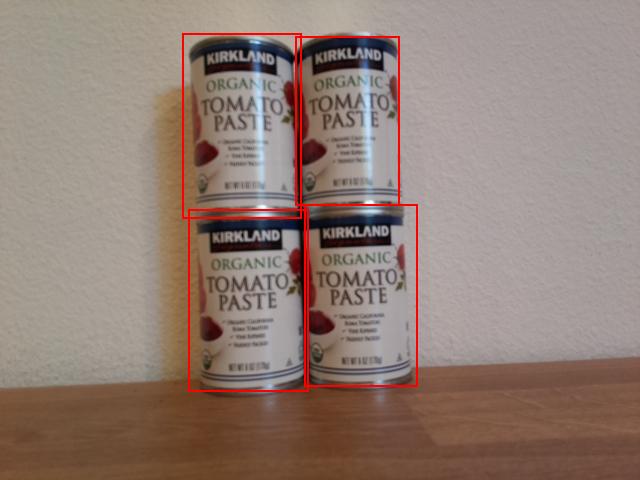從你的物聯網設備 - Wio Terminal 計算庫存
可以使用預測和它們的邊界框的組合來計算圖像中的庫存。
計算庫存

在上圖中,邊界框有一點重疊。如果這種重疊更大,那麼邊界框可能表示同一個物體。為了正確計算物體數量,你需要忽略具有顯著重疊的框。
任務 - 忽略重疊計算庫存
-
如果尚未打開,請打開你的
stock-counter專案。 -
在
processPredictions函數上方,添加以下代碼:const float overlap_threshold = 0.20f;這定義了在邊界框被認為是同一個物體之前允許的重疊百分比。0.20 定義了 20% 的重疊。
-
在這之下,並在
processPredictions函數上方,添加以下代碼來計算兩個矩形之間的重疊:struct Point {
float x, y;
};
struct Rect {
Point topLeft, bottomRight;
};
float area(Rect rect)
{
return abs(rect.bottomRight.x - rect.topLeft.x) * abs(rect.bottomRight.y - rect.topLeft.y);
}
float overlappingArea(Rect rect1, Rect rect2)
{
float left = max(rect1.topLeft.x, rect2.topLeft.x);
float right = min(rect1.bottomRight.x, rect2.bottomRight.x);
float top = max(rect1.topLeft.y, rect2.topLeft.y);
float bottom = min(rect1.bottomRight.y, rect2.bottomRight.y);
if ( right > left && bottom > top )
{
return (right-left)*(bottom-top);
}
return 0.0f;
}這段代碼定義了一個
Point結構來存儲圖像上的點,並定義了一個Rect結構來使用左上角和右下角坐標定義矩形。然後它定義了一個area函數,該函數從左上角和右下角坐標計算矩形的面積。接下來,它定義了一個
overlappingArea函數,該函數計算兩個矩形的重疊面積。如果它們不重疊,則返回 0。 -
在
overlappingArea函數下方,聲明一個函數來將邊界框轉換為Rect:Rect rectFromBoundingBox(JsonVariant prediction)
{
JsonObject bounding_box = prediction["boundingBox"].as<JsonObject>();
float left = bounding_box["left"].as<float>();
float top = bounding_box["top"].as<float>();
float width = bounding_box["width"].as<float>();
float height = bounding_box["height"].as<float>();
Point topLeft = {left, top};
Point bottomRight = {left + width, top + height};
return {topLeft, bottomRight};
}這會從物體檢測器中獲取預測,提取邊界框並使用邊界框上的值來定義矩形。右側是從左加上寬度計算得出的。底部是從頂部加上高度計算得出的。
-
需要將預測彼此進行比較,如果兩個預測的重疊超過閾值,則需要刪除其中一個。重疊閾值是百分比,因此需要乘以最小邊界框的大小,以檢查重疊是否超過邊界框的給定百分比,而不是整個圖像的給定百分比。首先刪除
processPredictions函數的內容�。 -
將以下內容添加到空的
processPredictions函數中:std::vector<JsonVariant> passed_predictions;
for (int i = 0; i < predictions.size(); ++i)
{
Rect prediction_1_rect = rectFromBoundingBox(predictions[i]);
float prediction_1_area = area(prediction_1_rect);
bool passed = true;
for (int j = i + 1; j < predictions.size(); ++j)
{
Rect prediction_2_rect = rectFromBoundingBox(predictions[j]);
float prediction_2_area = area(prediction_2_rect);
float overlap = overlappingArea(prediction_1_rect, prediction_2_rect);
float smallest_area = min(prediction_1_area, prediction_2_area);
if (overlap > (overlap_threshold * smallest_area))
{
passed = false;
break;
}
}
if (passed)
{
passed_predictions.push_back(predictions[i]);
}
}這段代碼聲明了一個向量來存儲不重疊的預測。然後它遍歷所有預測,從邊界框創建一個
Rect。接下來,這段代碼遍歷剩餘的預測,從當前預測之後的那個開始。這樣可以防止預測被多次比較 - 一旦 1 和 2 被比較,就不需要再比較 2 和 1,只需與 3、4 等進行比較。
對於每對預測,計算重疊面積。然後將其與最小邊界框的面積進行比較 - 如果重疊超過最小邊界框的閾值百分比,則預測標記為未通過。如果在比較所有重疊後,預測通過檢查,則將其添加到
passed_predictions集合中。💁 這是一種非常簡單的方法來消除重疊,只是刪除重疊對中的第一個。在生產代碼中,你可能需要在這裡添加更多邏輯,例如考慮多個物體之間的重疊,或者一個邊界框是否包含在另一個邊界框中。
-
在此之後,添加以下代碼以將通過的預測詳細信息發送到串行監視器:
for(JsonVariant prediction : passed_predictions)
{
String boundingBox = prediction["boundingBox"].as<String>();
String tag = prediction["tagName"].as<String>();
float probability = prediction["probability"].as<float>();
char buff[32];
sprintf(buff, "%s:\t%.2f%%\t%s", tag.c_str(), probability * 100.0, boundingBox.c_str());
Serial.println(buff);
}這段代碼遍歷通過的預測並將其詳細信息打印到串行監視器。
-
在此之下,添加代碼以將計數的項目數打印到串行監視器:
Serial.print("Counted ");
Serial.print(passed_predictions.size());
Serial.println(" stock items.");然後可以將其發送到物聯網�服務,以在庫存水平低時發出警報。
-
上傳並運行你的代碼。將相機對準架子上的物體,然後按 C 按鈕。嘗試調整
overlap_threshold值以查看預測被忽略的情況。Connecting to WiFi..
Connected!
Image captured
Image read to buffer with length 17416
tomato paste: 35.84% {"left":0.395631,"top":0.215897,"width":0.180768,"height":0.359364}
tomato paste: 35.87% {"left":0.378554,"top":0.583012,"width":0.14824,"height":0.359382}
tomato paste: 34.11% {"left":0.699024,"top":0.592617,"width":0.124411,"height":0.350456}
tomato paste: 35.16% {"left":0.513006,"top":0.647853,"width":0.187472,"height":0.325817}
Counted 4 stock items.
💁 你可以在 code-count/wio-terminal 文件夾中找到此代碼。
😀 你的庫存計數程序成功了!